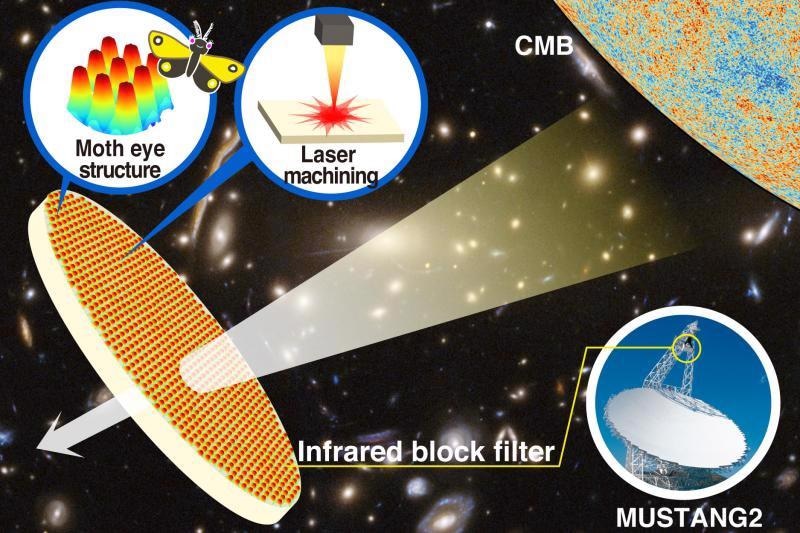Researchers from the Kavli Institute for the Physics and Mathematics of the Universe and the University of Minnesota, Tomotake Matsumura and Shaul Hanany, respectively, and their collaborators have created a new kind of optical element that will enhance the performance of telescopes analyzing radiation from the Big Bang.
 A schematic diagram showing how researchers can study radiation from the early universe using an infrared reflective filter with a moth-eye structure created by a pulsed laser process. (Image Credit: NASA, ESA, M. Postman (STScI), and the CLASH Team/NRAO, AUI, NSF/modified by Kavli IPMU).
A schematic diagram showing how researchers can study radiation from the early universe using an infrared reflective filter with a moth-eye structure created by a pulsed laser process. (Image Credit: NASA, ESA, M. Postman (STScI), and the CLASH Team/NRAO, AUI, NSF/modified by Kavli IPMU).
The cosmic microwave background (CMB) is an ancient radiation leftover from the Big Bang. It reaches telescopes on earth after traveling 14 billion years since the birth of the Universe. Examining the properties of this radiation, researchers deduce the physics of the Big Bang, the matter and energy content in the Universe and how groups of galaxies form. Four Nobel prizes have been conferred for past studies covering the CMB.
To explore the CMB, telescopes have to be adjusted to wavelengths in which it is most intense, around 1-3 mm, and they must isolate shorter wavelength radiation that is discharged by the atmosphere and Milky Way.
Among the most efficient optical elements that capture the short wavelength radiation but allow the CMB to travel through is alumina, a material composed of oxygen and aluminum, and after diamond, the second hardest material.
One issue with using alumina is that it also reflects nearly 50% of the radiation impacting it. Matsumura and Hanany have currently formulated a new way to manufacture anti-reflective structures that decrease reflections 50-fold.
The team collaborated with Mark Devlin and Simon Dicker, colleagues at the University of Pennsylvania who are operating the MUSTANG2 instrument, which is integrated with the Green Bank Telescope in Virginia.
Matsumura and Hanany provided the MUSTANG2 team with an alumina short-wavelength absorber that comprises the new anti-reflective structures. The MUSTANG2 instrument is presently carrying out sky observations with the new technology, displaying for the first time its effectiveness.
The scientists designed the alumina with tiny pyramidal structures, which are approximately one millimeter tall (0.04 inch) and repeat across the 30 cm (1 ft.) diameter with a periodicity below 1 mm. It has been known for a long time that integrating such structures on the surfaces of materials decreases reflections.
With the tiny pyramids, light penetrates and leaves the material more slowly, resulting in a much lower reflection. Matsumura and Hanany’s innovation is in the way they designed the alumina, which is extremely hard to be machined with basic tools. They employed ultra-short pulsed laser, with pulses a few trillionths of a second long and touching 100 megawatts each, to ablate the material away and to condition the surface relief to its best anti-reflective shape.
Within approximately 4 days, the laser process generated 320,000 pyramids on both sides of the alumina disk. The scientists computed the properties of the alumina sample and revealed that it reflects below 1% of the incident radiation. This is the first time an optical element of this standard has been produced and combined with an operating instrument, and it is the biggest sample of alumina to have been laser-ablated.
This advancement will make way for more efficient instruments gazing back in time, exposing the physical process at the Big Bang and spanning the Universe’s evolution.
Journal Reference:
Takaku, R., et al. (2021) Large diameter millimeter-wave low-pass filter made of alumina with laser-ablated anti-reflection coating. Optics Express. doi.org/10.1364/OE.444848.